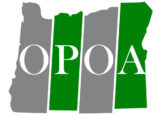
Cabins like this one will be harder to find thanks to House Bill 2225.
For rural Oregon property owners, there was a bad bill that was approved by the Oregon Legislature earlier this year. That bill is House Bill 2225. HB 2225 applies to rural property owners – specifically, owners of land zoned for forest uses. Since over eight million acres of private land in Oregon are zoned for forest use, HB 2225 impacts a significant number of Oregonians.
The bill makes changes to ORS 215.750, also known as the “template dwelling” statute. For over 40 years, Oregon’s Land Conservation and Development Commission (LCDC) has made it difficult for owners of farm and forest land to build a home on their property. Allowing a property owner to build a single home to live on their property is considered a basic right in 49 other states, but not in Oregon.
Instead, Oregon has enacted a complex set of statutes and rules making it difficult for rural Oregonians to live on their own property. On forest zoned properties, the primary method for obtaining approval to build a home on your land is through an application for a “template dwelling.”
The “template dwelling” statute is found at ORS 215.750. The name is derived from the statutory requirements. In order to receive approval for a template dwelling, the county will place a 160-acre template on top of a map of the property, and count the number of neighboring parcels and dwellings that are located within the template. If there are enough parcels/dwellings wholly or partially within the template, then the owner will qualify for a dwelling.
The purpose of the template dwelling statute is to enable additional development in areas zoned for forest use that are already divided into smaller parcels with houses. These areas are less likely to be used for commercial timber activity, so allowing additional development is not considered harmful.
The legislature also allowed property owners to work with their neighbors and use a property line adjustment to qualify a parcel for a dwelling. A property owner could work with the neighboring owner to adjust the boundaries between the two parcels so that each parcel could qualify for its own dwelling using the template test.
Finally, the legislature authorized property owners to change their ownership of two adjacent parcels so that each parcel could qualify for a template dwelling. For example, if Mr. and Mrs. Jones owned two adjoining parcels, they could change their deeds to the property so that Mr. Jones owned one parcel and Mrs. Jones owned the neighboring parcel, allowing each parcel to qualify for a dwelling. Mr. and Mrs. Jones could then sell the second parcel, gift it to their children, etc., and the new owner could build a home on the land.
The template dwelling laws were first enacted in 1993, and have given many Oregon families the ability to live on their land. Unfortunately, there are those who don’t want people to live in rural areas. Typically, these are people known as NIMBY’s, which stands for “Not in My Backyard”.
NIMBY’s opposed to template dwellings are those who live in rural areas and want to stop their neighbor from doing the same thing. It’s fine for them to live in the rural area, but no one else should be afforded the same right.
Unfortunately, the NIMBY’s have friends in the legislature. In fact, they were able to convince their friends to introduce HB 2225. As originally drafted, the bill would have eliminated virtually all template dwelling applications. In other words, it would have prevented forest landowners from building a home on their property.
As you can imagine, OIA/OPA led the charge to defeat the bill as introduced. In fact, we were able to convince the legislature to amend the most onerous provisions of the bill to blunt its impact significantly. Despite those efforts, however, the bill still has a significant impact on forestland owners wishing to qualify for a template dwelling.
The bill significantly limits the ability of property owners to use property line adjustments or deed changes to adjoining properties to qualify for a template dwelling. In other words, when the bill takes effect, a property owner whose parcel does not qualify for a template dwelling will not be able to use a property line adjustment to change the parcel boundary with a neighboring parcel in order to qualify the land for a template dwelling.
In addition, and using our example from above, Mr. and Mrs. Jones will no longer be allowed to change the ownership of their two parcels so that each parcel will qualify for a template dwelling. They can still change the ownership, but the change won’t be effective for the template test.
Fortunately, there is still time for forestland property owners to take action under the current law, not HB 2225. The bill establishes three separate applicability dates. In Clackamas, Jackson, Lane, and Polk Counties, the bill takes effect on January 1, 2020. For Columbia, Coos, Curry, Deschutes, Douglas, Josephine, Linn, Marion, Washington and Yamhill Counties, the bill takes effect on November 1, 2021. In the remaining counties the bill takes effect on January 1, 2023.
That means that property owners in Clackamas, Jackson, Lane and Polk Counties that are interested in establishing template dwellings should begin the process immediately. If you submit an application before January 1, 2020 in those four counties, the “old” law applies, not HB 2225.
For property owners in the other 32 counties, despite having an effective date that is more than two years away, it is advisable to get the process started now.
To read House Bill 2225, go to: https://olis.leg.state.or.us/liz/2019R1/Downloads/MeasureDocument/HB2225/Enrolled
